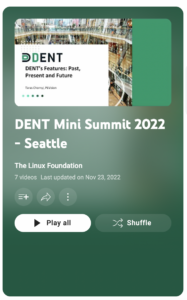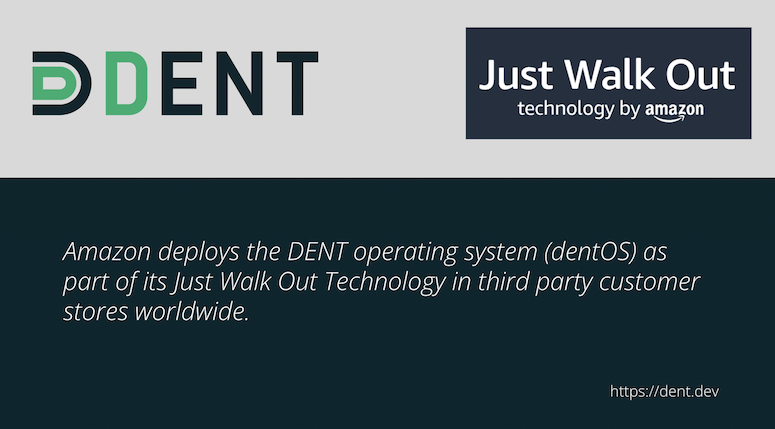Newest version of DENT, a Linux Foundation project, adds secure scaling, PoE control, and traffic policing, being deployed in retail environments in North America and Asia markets
Available for immediate download and testing; new Getting Started documentation available, supported hardware platforms list expanded
SAN FRANCISCO, March 8, 2022 – The DENT Project, an open source network operating system utilizing the Linux Kernel, Switchdev, and other Linux based projects, today announced DENT 2.0 is available for immediate download. The “Beeblebrox” release adds key features utilized by distributed enterprises in retail and remote facilities, providing a secure and scalable Linux-based Network Operating System (NOS) for disaggregated switches adaptable to edge deployment. DENT provides a smaller, more lightweight NOS for use at the small, remote edges of enterprise networks.
DENT 2.0 adds secure scaling with Internet Protocol version 6 (IPv6) and Network Address Translation (NAT) to support a broader community of enterprise customers. It also adds Power over Ethernet (PoE) control to allow remote switching, monitoring, and shutting down. Connectivity of IoT, Point of Sale (POS), and other devices is highly valuable to retail storefronts, early adopters of DENT. DENT 2.0 also adds traffic policing, helping mitigate attack situations that overload the CPU.
“DENT has made great strides this past year and with its edge and native Linux approach, with a rich feature set for distributed enterprises like retail or remote facilities. DENT continues to expand into new use cases and welcomes community input with an open technical community, under the Linux Foundation,” said Arpit Joshipura, GM of Networking & Edge at The Linux Foundation.
DENT 2.0 Main Features to enable secure and scalable development
- Secure scaling with IPv6 and NAT to appeal to a broader community of SME customers
- PoE control to allow remote switching, monitoring, and shutting down
- Rate limiting to protect against broadcast storms, creating a stronger OS under erroneous BUM (Broadcast, Unicast, Multicast) traffic
DENT goes beyond the data center to enable enterprises to transition to disaggregated network switches and use cases available with the distributed enterprise and edge networking. The open source NOS provides key technology leverage in retail, a sector that is leading innovation in digital transformation. The Amazon public showcase of DENT hardware at re:Invent in November 2021 reached 20,000+ attendees.
“This new release of DENT 2.0 adds critical updates focused on smaller enterprise needs. This was the goal of DENT all along, and I would like to thank our members and the wider community for this broad, concerted effort to move DENT significantly forward,” said Steven Noble, DENT Technical Steering Committee Chair. “It’s not easy building a flexible, accessible network OS, and this is why I’m proud of all the effort and coordination by so many talented individuals. If you are looking for an open source disaggregated network OS, now is great timing for looking at DENT.”
Retail stores, warehousing, remote locations, enterprise, and Small and Mid-Size Enterprises are all ideal environments for DENT deployment. Wiring closets in many facilities are small. Staff expertise may be limited, and branch-office switches from leading suppliers can require costly contracts. DENT is easily deployed on white-box hardware in small spaces. It can be set up to support dozens of wireless access points and IoT sensors, creating a manageable network to track inventory, monitor shelf real estate, scan customer activity, and perform automated checkouts.
DENT premier members include Amazon, Delta Electronics Inc, Edgecore Networks, and Marvell. DENT would also like to acknowledge important contributions from NVIDIA, Keysight Technologies, and Sartura.
To download and start testing DENT 2.0 today: https://github.com/dentproject/dentOS
To join DENT technical working groups: https://lists.dent.dev/g/tsc/calendar
Supporting Quotes
“Delta has built complete white box networking platforms based on DENT technology, helping drive a disaggregation model in edge that offers cost and flexibility benefits to customers looking for OEM solutions,” said Charlie Wu, Vice President, Solution Center at Delta Networks. “The deployment of our 1G and 10G Ethernet switch boxes with Marvell’s Prestera devices and the DENT OS in real world applications demonstrates the power of open source to accelerate technology innovation in networking.”
“Edgecore Networks, as the premier member of DENT, is pleased to see the groundbreaking second release of DENT 2.0, enabling DENT community members to use the DENT’s simplified abstracts, APIs, drivers, to lessen development and deployment overhead,” said Taskin Ucpinar, Senior Director of SW Development at Edgecore Networks. “This innovative product development approach enables the community to build robust solutions with minimal effort and immediately help System Integrators deploy a networking solution to remote campuses and retail stores.”
“As the chairing company for DENT Test Working Group, Keysight has partnered with the open-source community to host the system integration test bed in Keysight labs,” said Dean Lee, Senior Director Cloud Solution Team at Keysight Technologies. “Being a neutral test vendor, we have worked with the community to harden the DENT NOS in multi-vendor interoperability, performance and resiliency. We are delighted to contribute to the success and wide adoption of DENT.
“Marvell is accelerating the build-out of Ethernet switching infrastructure in emerging edge and borderless enterprise applications, and DENT is a key component to our offerings,” said Guy Azrad, Senior Vice President and General Manager, Switch Business Unit at Marvell. “With DENT incorporated on our Prestera® switch platforms, we are currently enabling retailers to transform physical stores to smart retail connected environments that benefit consumers through easy and efficient in-store experiences.”
Additional DENT Resources
About the Linux Foundation
Founded in 2000, the Linux Foundation is supported by more than 1,000 members and is the world’s leading home for collaboration on open source software, open standards, open data, and open hardware. Linux Foundation’s projects are critical to the world’s infrastructure including Linux, Kubernetes, Node.js, and more. The Linux Foundation’s methodology focuses on leveraging best practices and addressing the needs of contributors, users and solution providers to create sustainable models for open collaboration. For more information, please visit us at linuxfoundation.org.
###
The Linux Foundation has registered trademarks and uses trademarks. For a list of trademarks of The Linux Foundation, please see our trademark usage page: https://www.linuxfoundation.org/trademark-usage. Linux is a registered trademark of Linus Torvalds.



 The DENT community held its first Mini-Summit, “NOS for the Distributed Edge: A Mini-Summit on DENT Ecosystem,” in November 2022 alongside ONE Summit. The mini-summit featured 7 session presentations with almost 70 attendees (both in-person and virtually).
The DENT community held its first Mini-Summit, “NOS for the Distributed Edge: A Mini-Summit on DENT Ecosystem,” in November 2022 alongside ONE Summit. The mini-summit featured 7 session presentations with almost 70 attendees (both in-person and virtually).